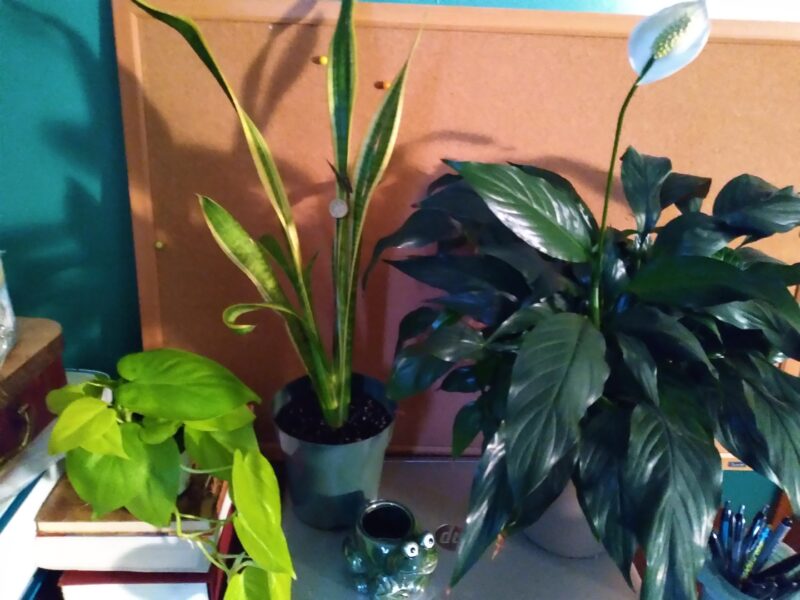Houseplants for dorm rooms
Plants may not be the first consideration in adding a personal touch to a dorm room, but they will add a touch of color and improve the mood of even the drabbest space.
What makes a plant suitable for growing in a dorm room? Easy care and low maintenance top the list, as well as slow growth or compact size.

The snake plant (Dracaena trifasciata, formerly known as Sansevieria trifasciata), is sometimes called mother-in-law’s tongue or Saint George’s sword. Variegated, stiff, spear-shaped leaves grow straight up from a rosette-shaped base.
Don’t worry if space is limited. This plant grows slowly. Snake plant will tolerate low light conditions and irregular watering.
It grows a bit faster with brighter light. Beware of watering too much or the roots will rot. Allow it to dry out between watering and water sparingly.
In contrast, the peace lily (Spathiphyllum) sports single white flowers (called spaths) above dark green foliage. It prefers moist, but not wet, soil. If you forget to water, this plant will remind you when its leaves droop.
Give it a good watering, being sure to empty any water accumulated in the saucer. Let the soil dry a bit between waterings. Peace lilies grow in medium to low light, such as a north-facing window. Avoid bright, direct sun.
Are you looking for a bit of visual fun?
Lucky bamboo (Dracaena sanderiana) can be found trained into spirals, even woven into decorative designs. Contrary to its common name, lucky bamboo isn’t really bamboo. This easy-to-care-for plant prefers bright, indirect, filtered light. Avoid direct sunlight. It’s often grown with no soil in a container of pebbles and water.
When watering, use tap water that has been sitting at room temperature for at least a day to allow chlorine to evaporate, or use bottled water. Change water periodically, and don’t let the water level get below an inch. If grown in soil, be sure it’s well drained, not soggy.
Pothos (Epipremnum aureum) and heartleaf philodendron (Philodendron hederaceum) are equally suitable for the desktop, trailing from the top of a bookcase or a hanging basket. These vining houseplants are easy to care for, requiring indirect light and watering about once a week. Allow soil to dry a bit between waterings.
Aloe vera (Aloe barbadensis miller) and other succulents are good alternatives for bright spaces. They prefer six hours of bright, indirect light a day.
Be sure the potting mix drains well, as excess water will result in rot. In general, water every few weeks. Aloe vera sports thick, fleshy leaves with serrated edges, but succulents come in many sizes and shapes.
If you already have a favorite plant that requires bright light but room conditions are medium to low light, single-plant grow lights are available.
If conditions are dry but your plant likes humidity, mist daily and place on a tray of pebbles filled with water. Be sure to keep any drainage hole in the pot above the water level.
What if there’s absolutely no room for a plant?
Consider an air plant (Tillandsia). In nature, air plants grow on other plants and have no need for soil. They require little care and can be placed anywhere there is bright, indirect light.
Water air plants by misting with a spritz of water a few times a week and periodically by submerging in water for 30 minutes. Let dry, then return to its usual location.
No matter what the conditions, there’s always room for a bit of nature in a dorm room, and there’s a plant that will grow there.
For more information and to view the Houseplant Hero video series, visit the University of Vermont Extension Master Gardener resources website and click on the “Houseplants” tab.
(Deborah J. Benoit is a University of Vermont Extension master gardener from North Adams, Mass., who is part of the Bennington County Chapter.)

